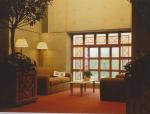Site Area: 14171.8 square metres; Area covered by building: 3870 square metres; Parking: 134 spaces.
The Aga Khan noted at the Foundation ceremony: “I succeeded my Grandfather to the office of Imam in 1957, and just two weeks ago on the 11th of July, I entered the twenty-fifth year of my Imamat. During the Jubilee year many new projects will be launched which will impact the material quality of the life of Ismailis and indeed of many others, in the fields of health, education, housing and rural development, particularly in the Third World…But this is the first project to be launched during this Jubilee year and it is very important that it is a place of worship.”
 The Aga Khan explaining the Model to some of the guests at the Foundation Ceremony Architect Bruno Freschi at the foundation ceremony with distinguished guests, being explained the model of the JamatkhanaIsmaili Jamatkhana and Centre, Burnaby, Bird’s View, 1985. The surronding area is now significantly different with new residential and commercial development. The picture provides a view of the five copper domes on the roof of the building.
The Aga Khan explaining the Model to some of the guests at the Foundation Ceremony Architect Bruno Freschi at the foundation ceremony with distinguished guests, being explained the model of the JamatkhanaIsmaili Jamatkhana and Centre, Burnaby, Bird’s View, 1985. The surronding area is now significantly different with new residential and commercial development. The picture provides a view of the five copper domes on the roof of the building.
Architect Bruno Freschi at the foundation ceremony with distinguished guests, being explained the model of the Jamatkhana
The Ismaili Jamatkhana and Centre was opened by Prime Minister Brian Mulroney in the presence of His Highness the Aga Khan, on August 23, 1985, as the plaque text illustrates. Bruno Freschi writes: “I believe the ultimate purpose of the Jamatkhana is giving iconic foundation to the Ismaili community in Canada. Both His Highness’s and the Prime Minister’s comments in their speeches reflected this very Canadian idea.”
Bruno Freschi’s Masterpiece – the Iconic Jamatkhana and Ismaili Centre Burnaby located on 4010 Canada Way, Burnaby (part of Greater Vancouver). Seen here from Curle Avenue.
Ismaili Jamatkhana and Centre, Burnaby. One of the window alcoves in the social hall, where one may read, converse or relax.
Ismaili Jamatkhana and Centre, Burnaby. A side elevation window, in opalescent cast glass showing decorative patterns lit from within.
Ismaili Jamatkhana and Centre, Burnaby. Main entrance portal – solid oak doors are inlaid with brass strips. Says Bruno Freschi: “The Jamatkhana is a very special and uniquely spiritual building. Spiritual architecture is a unique design challenge because the architecture must be simultaneously an iconic, symbolic form, complete and unequivocal yet it must transform and become ephemeral. Indeed the building is an aesthetic statement which symbollically represents a greater belief, one goes in to go out. The spirituality of the place is embodied in going beyond place, to go out”.
Says Bruno Freschi: “Geometry governs the entire site, the building. It is symbolized in the octagon, the ‘mythical squaring of the circle’. The Octagon is omni-directional. All axial relationships are equal providing an open and non-hierarchical circulation: The centre is everywhere, and everyone is in the centre.”
Says Bruno Freschi: “Materiality, the exposure of earth materials, concrete, sandstone, and marble gives a material presence and permancence, symbols of a ‘timeless’ foundation for the Ismaili community.”
Says Bruno Freschi: “Calligraphy is incorporated throughout the building. The spiritual voice is reflected in the graphic designs on tile work, the glass windows, carpets and wood screens. Whilst abstract, the calligraphy is both traditional and spiritually evocative.”
Says Bruno Freschi: “An example of ‘going out’ That ephemeral quality of spiritual space can be best seen in the calligraphy on the glazing of the windows. The glass is one inch thick providing acoustic insulation. The graphics are fired on both surfaces of the glass.
Seen at an angle, the calligraphic images are dual and ambigious, they visually vibrate to the comtemplative viewer. This is ‘signalectic’ architecture, the threshold of the ephemeral sanctuary of spiritual space.”
Says Bruno Freschi: “The Jamatkhana incorporates a powerful relentless set of elements. Architecture is the unity of these elements and principles expressed in the building structural narrative, a pattern of octagonal and domed structures giving the sense of unity and universallity.”
“A Remarkable Achievement”, says His Highness the Aga Khan’s handwritten message to Mr. Bruno Freschi.
“Imagination, Care, Sensitivity and Respect”, says Prince Amyn Muhammad Aga Khan’s written message to Mr. Bruno Freschi.
The Ismaili Centre, Burnaby, in foreground against a backdrop of the West Coast Mountains.
“In Islam man is answerable to God for whatever he has created and this is reflected in its architectural heritage. Many of the greatest architectural achievements in Islam were designed to reflect the promises of the life hereafter, to represent in this world what we are told of next. Since all that we see and do resonates on the faith the aesthetics of the environment we build and the quality of the social interactions that take place within these environments reverberate on our spiritual life. It is with this in mind that the Burnaby Jamat Khana has been conceived.”
His Highness the Aga Khan, on July 26, 1982, at the Foundation Ceremony
________________
Please read full interview at: Voices: Bruno Freschi, Architect of the Ismaili Centre in Burnaby, in Conversation with Simerg
We welcome feedback/letters from our readers.
Please use the LEAVE A REPLY box which appears below. Your feedback may be edited for length and brevity, and is subject to moderation. We are unable to acknowledge unpublished letters.
Please visit the Simerg Home page for links to articles posted most recently. For links to articles posted on this Web site since its launch in March 2009, please click What’s New. Sign-up for blog subscription at top right of this page.




















